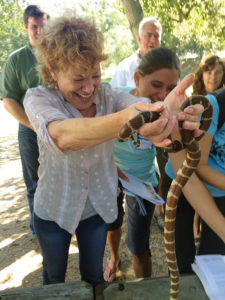By Laurel Busby
Staff Writer
The unique ecosystem of the Santa Monica Mountains will be delineated and explored in a fall docent training program at Topanga State Park.
“It is the most wonderful naturalist education I can imagine,” said Palisadian Read Howarth, who grew up in New Jersey and first took the training two years ago to learn about the vastly different landscape here. He now re-enrolls each fall to further his knowledge. “It is just phenomenal—the breadth of it and the quality of the instructors.”

Experts in the field, including a Chumash elder and professors from UCLA, Pepperdine and Northridge, share their knowledge about local history, plants and animals in a series of six full-day classes and five three-hour walks. The training is replete with explorations of indigenous plants and animals, Howarth said.
For example, in a previous training Howarth learned about the Big Berry manzanita plant, which is pollinated by a local bumblebee. This bee actually detaches its flight muscles from its wings and then vibrates its muscles in a way that changes the buzzing’s sound frequency to a middle C. That frequency makes the plant release its pollen.

Photo: Lucinda Mittleman
Professor Doug Allen, a recently retired Santa Monica College professor, “brings out a black piece of construction paper and a tuning fork,” Howarth said. Allen strikes the tuning fork next to the flower, and “you can see the pollen drop onto the paper. It’s dramatic.”
Graduates of the program, which costs $85, can volunteer as docents either by helping out at the Trippet Ranch Visitor Center or by joining hikes as either a leader or assistant.
Docents are encouraged to create their own hikes, and Howarth has titled his the “Seven Wonders of the Santa Monica Mountains.” During this hike, which he has only been able to lead once so far due to the park’s already full schedule, he talks about some of the particularly intriguing animals and features of the local mountains.
For example, he discusses both acorn woodpeckers and Western fence lizards. The woodpeckers live in a communal society with up to three females nesting together inside a tree. “While the entire community helps in gathering and storing food and raising the young, that cooperative behavior only goes so far,” Howarth said. “If one of the females starts laying eggs before the others, the other breeding females will push those eggs out of the nest until all are laying eggs at the same time.”
The lizards are unusual in that they may be the reason that the incidence of Lyme disease is lower in local mountains than in other areas of the country, Howarth said. Ticks in the nymph state can feed on fence lizards, and research suggests a protein within the lizard’s blood seems to neutralize Lyme disease in the feeding ticks.

The training also teaches about the local “Mediterranean” climate with its warm, dry summers and mild, rainy winters.
“Though only 2.25% of the world’s land area fits into the Mediterranean category, these regions have the richest biodiversity on the planet,” said Howarth, a disability insurance broker and father of three grown children, who works with his brother Fred, also a Palisadian. “The Santa Monica Mountains represent one of the best intact examples of this biologically diverse Mediterranean ecosystem.”
The classroom and in-the-field training take place at the Trippet Ranch Visitor Center in Topanga State Park, with Saturday classroom training on Sept. 10 and 24, Oct. 8 and 22, and Nov. 5 and 19 from 9:30 a.m. to 3:30 p.m. In addition, five interpretive walks are held on Sunday mornings from 9:30 a.m. to 12:30 p.m.on Sept. 18, Oct. 2, 16, and 30, and Nov. 13.
Enrollees receive a one-year parking pass to Topanga State Park and invitations to various gatherings, hikes and workshops throughout the year. To register, visit: www.topangacanyondocents.org/register-now-for-the-fall/.












You must be logged in to post a comment.